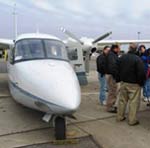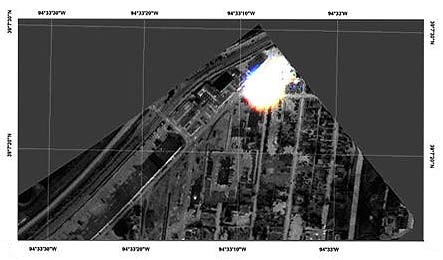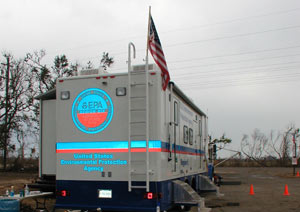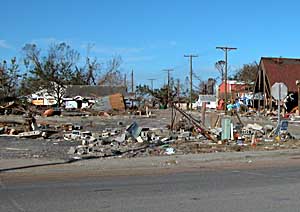Hollywood Doesn’t Always Portray Things From the Right ASPECT
Friday, January 2nd, 2009About the author: Jeffrey Robichaud is a second generation scientist with EPA who started in 1998. He serves as Chief of the Environmental Assessment and Monitoring Branch in Kansas City.
Movies require you to suspend your disbelief, but when you watch a film that hits close to home it can be tough. I have a friend in federal law enforcement who squirms when cardboard cutout agents run across the screen. Action flicks don’t do his profession justice, but at least his job is sometimes glorified on celluloid. The only two movies I can remember featuring a prominent EPA employee are Ghostbusters and the Simpsons Movie, neither of which ever made a kid say, “Man, when I grow up I want to work for the EPA.” On the off-chance your youngster was inspired to seek out public service please let them know we don’t inspect unlicensed nuclear storage facilities, nor do we have a fleet of helicopters. We do however, have one cool plane.
 EPA’s Airborne Spectral Photometric Collection Technology, known as ASPECT, is an aircraft equipped with sensors that allow for surveillance of gaseous chemical releases from a safe distance. ASPECT gives emergency responders information regarding the shape, composition and concentration of gas plumes from disasters such as a derailed train, factory explosion or terrorist attack.
EPA’s Airborne Spectral Photometric Collection Technology, known as ASPECT, is an aircraft equipped with sensors that allow for surveillance of gaseous chemical releases from a safe distance. ASPECT gives emergency responders information regarding the shape, composition and concentration of gas plumes from disasters such as a derailed train, factory explosion or terrorist attack.
Since its inception ASPECT has flown over several fires, provided support during the Olympics and Columbia shuttle recovery, and supplied some of the first aerial images of the devastation along the coast during Katrina.
 This was the scene in Kansas City outside our office windows in 2007 when a chemical facility went up in flames. ASPECT deployed and was instrumental in verifying that while ominous, the fire did not present a significant health threat to the community (the white signature you see below is the fire).>
This was the scene in Kansas City outside our office windows in 2007 when a chemical facility went up in flames. ASPECT deployed and was instrumental in verifying that while ominous, the fire did not present a significant health threat to the community (the white signature you see below is the fire).>
Most of the technology you see in movies is sheer fantasy, but EPA’s high-tech plane and the scientists who operate it are worthy of a spot in the next summer blockbuster. Here’s hoping for the appearance of an EPA scientist who isn’t a bad guy (although with my face the best I could hope for is Thug #4 in the next straight to DVD clunker).



 One might wonder what kind of damage occurs during a hurricane. I’ve enclosed another picture from Hurricane Rita showing damage in Cameron Parish. What I remember most from hurricanes Katrina and Rita were the number of trees uprooted, the number of church steeples blown off, the golden part of the McDonald’s arches being gone, and getting lost a lot because road signs were down. I am always amazed at the kind of destruction that Mother Nature can leave behind.
One might wonder what kind of damage occurs during a hurricane. I’ve enclosed another picture from Hurricane Rita showing damage in Cameron Parish. What I remember most from hurricanes Katrina and Rita were the number of trees uprooted, the number of church steeples blown off, the golden part of the McDonald’s arches being gone, and getting lost a lot because road signs were down. I am always amazed at the kind of destruction that Mother Nature can leave behind.